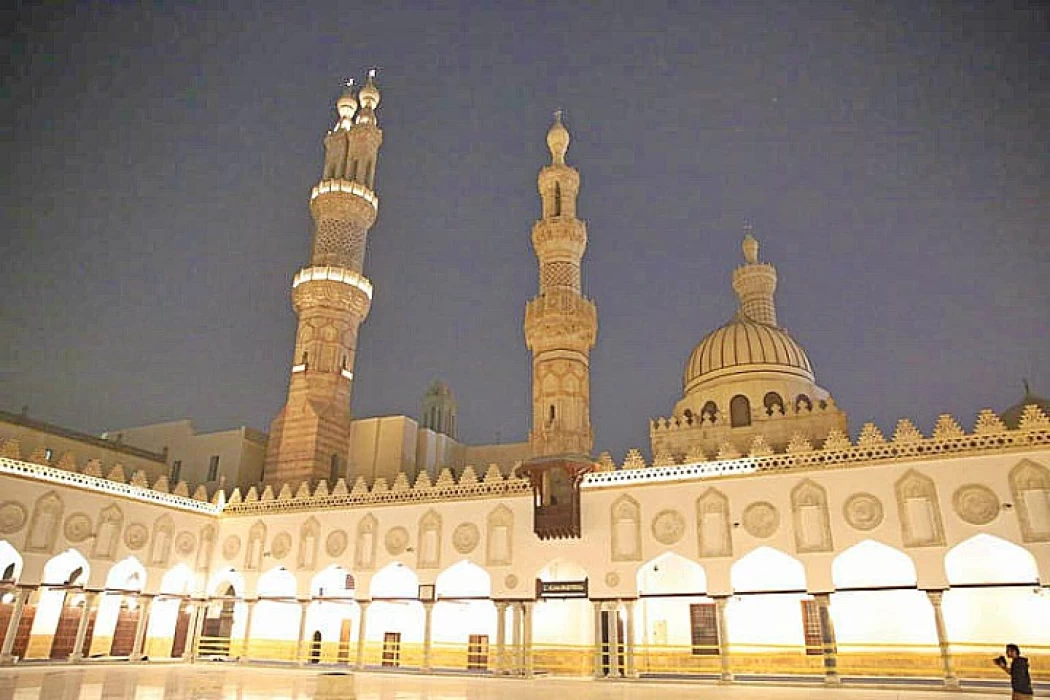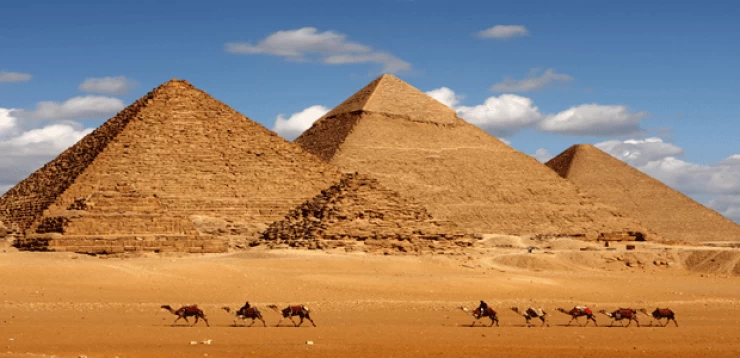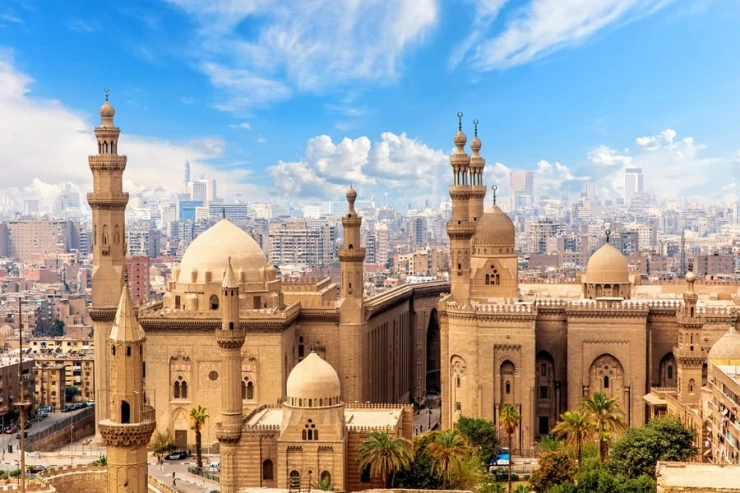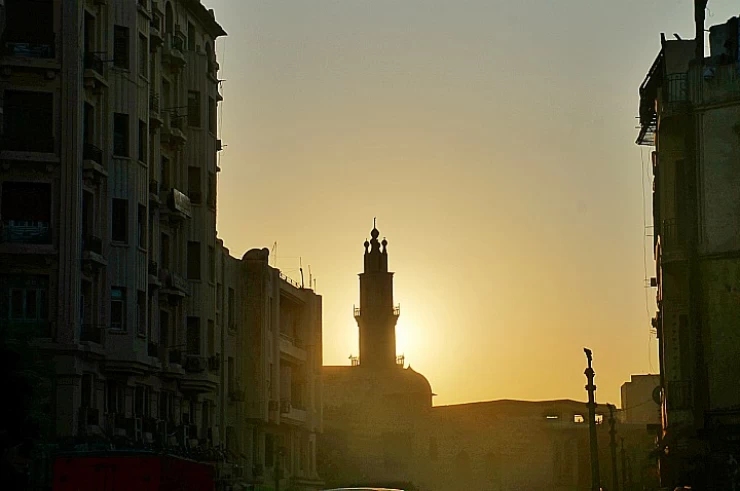
Moschea di Al Azhar
Moschea di Al Azhar
Al Cairo si trova la Moschea di Al Azhar è una delle moschee incredibili e le cose da fare al Cairo, è considerata la prima università della storia costruita più di mille anni fa al Cairo, le persone che visitano Khan El Khalili possono vedere la moschea durante i loro Cairo Day Tours.
Era verso la fine del decimo secolo per essere la moschea ufficiale per le preghiere della congregazione che si tenevano ogni venerdì ed è conosciuta in A rabic come Jummah.
Lo sviluppatore dell'affascinante Moschea di Al Azhar, che ha la stessa età della città del Cairo, è anche il grande capo dell'esercito fatimide e costruttore del Cairo, Gawhar El Seqelly, con gli ordini del califfo fatimide, Al Mui'z le Din Allah. La costruzione di Al Azhar, che deve essere vista durante i regolari pacchetti di viaggio in Egitto o tour giornalieri del Cairo dall'aeroporto, iniziò nel 970 d.C. e ci vollero circa tre anni per essere completata.
Progettazione architettonica della moschea di Al Azhar:
Inizialmente, Al Azhar è stata costruita su metà dell'area che occupa attualmente. Ampliamenti, nuovi edifici e restauri sono stati eseguiti da diversi califfi, re, sultani e presidenti d'Egitto durante le varie epoche fino a quando la moschea ha raggiunto le dimensioni e la forma che è oggi. La prima moschea di Al Azhar consisteva di tre Iwan o sale di preghiera, e al centro c'è una corte aperta chiamata Sahn. L'ingresso alla moschea si trovava verso ovest e questa sezione conteneva una semplice torre o come viene chiamato nell'architettura islamica Minareto progettato in stile fatimide. Questa sezione è stata decorata con iscrizioni islamiche Kofi e motivi floreali, che sono l'unica caratteristica rimasta dell'antica moschea che è ancora disponibile ora.
Tuttavia, la più grande architettura della Moschea Al-Azhar è stata eseguita da "Abd al-Rahman bin Katkhuda" nell'anno (1167 AH = 1753 dC) e lui era appassionato di costruzione e costruzione. Poi ha aggiunto al corridoio della qiblah un nuovo compartimento di preghiera separato dal compartimento originale da pilastri di pietra, e tre gradini si alzano da esso, e ha tre mihrab, e ha stabilito una grande porta dal lato nord-occidentale che attualmente si affaccia su Al-Azhar Square, composta da due porte adiacenti, nota come Porta di Muzain, e ha anche introdotto una nuova porta chiamata Porta di Al-Sa'idah e ha creato un minareto accanto ad essa che esiste ancora fino ad ora, e questa porta conduce all'Al- Sa'idah mesi. I corridoi di Al-Azhar.
Moschea Al Azhar Nel Periodo Fatimide
Forse la prima architettura introdotta ad Al-Azhar è stata realizzata dal califfo fatimide, che ha conservato la religione di Dio, al Cairo islamico, dove ha ampliato l'area dei portici; Nell'era mamelucca, i sultani si prendevano cura di Al-Azhar dopo l'incuria che subì nell'era ayyubide, e il principe "Izz al-Din Aydar fu il primo a preoccuparsi di Al-Azhar, quindi rinnovò le parti che erano state spezzate da lui. E nel suo splendore, la vita finì dopo una pausa, e la gente vi celebrò le preghiere del venerdì in quel giorno (18 Rabi` al-Awwal anno 665 AH = 19 novembre 1266 d.C.). che può essere visto oggi nel museo delle arti islamiche durante le gite di un giorno in Egitto al Cairo. Nel 1125 d.C., il sovrano fatimide Al Amer be'ahkam Allah istituì un Mihrab per la moschea (una nicchia che indica in che modo pregare verso la Ka'aba) realizzato in legno Aro turco che era decorato con molte forme floreali e geometriche .
Al Azhar nel periodo mamelucco:
L'architettura della moschea di Al-Azhar non si è fermata durante il regno dei mamelucchi circassi, dove il sultano Qaitbay Al-Mahmoudi (873 AH = 1468 d.C.) demolì la porta sul lato nord-occidentale della moschea, ricostruendola come è ora, e costruì alla sua destra un grazioso minareto dei più bei minareti del Cairo, poi il sultano Qansuh al-Ghuri costruì il minareto a due teste, il più alto dei minareti di Al-Azhar, uno stile unico del minareto che è raro nel Mondo islamico.
Una nuova madrasa (scuola religiosa), l'istituto di insegnamento islamico Tabrisy Madrasa, è stata costruita da Baybars Khazendar, il comandante dell'esercito durante il regno di Al Nasser Mohamed Ibn Qalaun. Si trova a destra quando si entra nella moschea Al Azhar. Ciò ha aggiunto uno spazio più grande alla Moschea che ospitava lezioni di insegnamenti islamici e aveva anche una grande biblioteca islamica.
La Madrasa Afghaweya fu costruita nel 1340 d.C. e si trova sul lato sinistro dell'ingresso. Contiene la biblioteca di Al Azhar nel tempo presente.
Al Azhar nell'era ottomana:
Al Azhar ha subito molta espansione nell'era ottomana. Il lavoro di costruzione più grande e più importante fu eseguito da Amir Abdel Rahman Katkhuda nel 1753 d.C. mentre ampliava l'area della moschea aggiungendo un riwaq (portico) dietro il mihrab che era costruito su un livello più alto dell'intera moschea. Ha anche aggiunto un nuovo minbar e mihrab. Katkhuda aggiunse anche due grandi porte: la prima nel muro meridionale chiamata porta Sa'ayda e la porta Shroba nella sezione orientale della moschea con un minareto aggiunto accanto. Katkhuda è stata anche responsabile della costruzione della bellissima porta occidentale con il suo straordinario Islam
Il nostro team vi aiuterà a viaggiare in Egitto e sperimentare il tempo soleggiato del nostro bel paese durante la Pasqua, grazie alla loro vasta conoscenza del turismo egiziano. Puoi personalizzare il tuo pacchetto selezionando uno dei nostri pacchetti di viaggio in Egitto o sfruttare al massimo il tuo tempo in una breve visita, imparando di più sulla storia egiziana e le sue affascinanti storie e vivendola attraverso tour privati al Cairo. Partecipa a uno dei nostri tour economici in Egitto attraverso il deserto del Sahara, come i tour di Siwa dal Cairo, per esempio, o preferibilmente i tour nel Deserto Bianco d'Egitto. Scoprite i nostri tour di un giorno ad Assuan.fate una gita di un giorno da Assuan ad Abu Simbel, o viaggiate via terra e godetevi i nostri tour di un giorno a Luxor per vedere gli incredibili templi di Karnak, il Tempio di Luxor, il Tempio di Hatshepsut, e vedete le meravigliose tombe splendidamente dipinte nella Valle dei Re, questo è il luogo dove i re e i governanti del nuovo regno riposano in pace e imparate i loro riti di mummificazione e sepoltura.
C'è una parte speciale del Cairo, in Egitto, chiamata Cairo islamica. Se ci si reca lì, si possono imparare molte cose interessanti su di essa.
Al Azhar Mosque |
Al Azhar house of prayer is one of the wonderful mosques and things to do in Cairo, it considered is the primary University in history engineered over one thousand years past in Cairo, folks visiting Khan El Khalili can see the house of prayer throughout their Cairo Day Tours. it had been towards the tip of the tenth century to be the official house of prayer for the congregational prayers control each Friday and is thought in a very rabic as Jummah.
The developer of the fascinating house of prayer of Al Azhar is as previous because the town of Cairo itself is additionally the good Fatimid army leader and also the builder of Cairo, Gawhar El Seqelly, with the orders of the Fatimid caliph, Al Mui'z le Din Allah. The building of Al Azhar that needs to be seen throughout the regular Egypt Travel Packages or Cairo day tours from the Airport began in 970 A.D. and it took around 3 years to be accomplished.
Architectural style Of Al Azhar Mosque: Initially, Al Azhar has engineered on 1/2 of the realm it occupies presently. Enlargements, new buildings, and restorations are meted out by many Caliphs, kings, sultans, and presidents of Egypt throughout the varied eras till the house of prayer reached the dimensions and the form it's nowadays. the first house of prayer of Al Azhar consisted of 3 Iwans or prayer halls, and within the center, there's an associate degree open court known as Sahn. the doorway to the house of prayer was set in toward the West and this section contained a straightforward tower or as known as in Muslim design tower designed within the Fatimid style. This section was adorned with Kofi Muslim inscriptions and floral motives, which are the sole remaining feature of the traditional house of prayer that's still obtainable currently.
However, the biggest design of the Al-Azhar house of prayer was performed by “Abd al-Rahman bin Katkhuda” within the year (1167 AH = 1753 AD) and he was keen on building and construction.
Then he else to the corridor of the qiblah a brand new prayer compartment separated from the initial compartment by stone pillars, and 3 steps rise from it, And it's 3 mihrabs, and established an oversized door from the northwestern aspect that presently overlooks Al-Azhar sq., consisting of 2 adjacent doors, referred to as the Gate of Muzain, and conjointly introduced a brand new door known as the Gate of Al-Sa'idah and created a tower beside it that also exists so far, and this door results in the Al-Sa’idah months. The corridors of Al-Azhar.
Al Azhar house of prayer within the Fatimid amount
Perhaps the primary design introduced to Al-Azhar was meted out by the Fatimid caliph, to preserve the faith of God, in Islamic Cairo, wherever he enhanced the realm porticos; within the Mamluk era, the sultans took care of Al-Azhar once the neglect it suffered within the Ayyubid era, and patrician “Izz al-Din Aydar was the primary to worry concerning Al-Azhar, thus he revived the elements that were cracked from him. And in its splendor, life came to an associate degree finish once a chance, and also the folks celebrated the Friday prayers in it on the day (18 Rabi` al-Awwal year 665 AH = nineteen Gregorian calendar month 1266AD). which will be seen nowadays within the depository of Muslim Arts throughout Egypt day tours in Cairo. In 1125 A.D., the Fatimid ruler Al Amer Be'ahkam Supreme Being established a Mihrab for the house of prayer (a niche that indicates that thanks to praying towards Ka'aba) created out of Aro Turkish wood that was adorned with loads of floral and geometric shapes.
Al Azhar within the Mamluk Period:

The design of the Al-Azhar house of prayer failed to stop throughout the reign of the Circassian Mamluks, wherever grand Turk Qaitbay Al-Mahmoudi (873 AH = 1468 CE) razed the door on the northwestern aspect of the house of prayer, engineered it once more because it is currently, and engineered on its right a sleek tower of the foremost lovely minarets of Cairo, Then grand Turk Qansuh al-Ghuri engineered the two-headed tower, the very best of the minarets of Al-Azhar, a novel variety of the tower that's rare within the Muslim world.
A new madrasa (religious school), the Tabrisy religious school Muslim teaching establishment, was engineered by Baybars Khazendar, the military commander during the reign of Al Nasser Mohamed Ibn Qalaun. it's set to the proper hand after you enter the Al Azhar house of prayer. This else a much bigger house than the house of prayer that hosted Muslim teachings categories and conjointly had an oversized Muslim library.
The Afghaweya religious school was inbuilt in 1340 A.D. and it's set on the left-hand aspect of the doorway. It contains the library of Al Azhar nowadays.
Al Azhar underwent plenty of growth within the Ottoman era. the {most important|the largest} and most important building work was done by the ruler Abdel Rahman Katkhuda in 1753 A.D. as he expanded the world of the house of prayer by adding a Riwaq (portico) behind the mihrab that was engineered on the next level than the full house of prayer. He additionally added a new minbar and mihrab. Katkhuda additional 2 nice gates as well: the primary within the southern wall referred to as the Sa'ayda gate and therefore the Shroba gate within the section of the house of prayer with an added minaret beside it. Katkhuda was additionally liable for building the attractive western gate with its superb Muslim decorations and that is currently the entrance of the house of prayer.
Al Azhar has been additionally renovated by the supreme council of antiquities to finally appear as if this within the trendy time throughout your visits to the house of prayer through the assorted Cairo overnight tours. Al Azhar as a house of prayer and as an academic establishment has to compete for a significant role in numerous centuries of Egyptian history, particularly in fighting the French and British occupation.


















